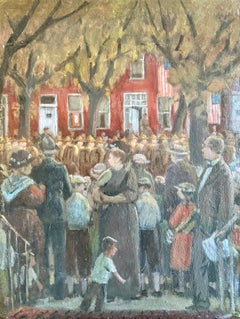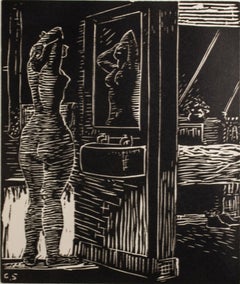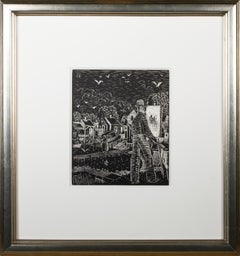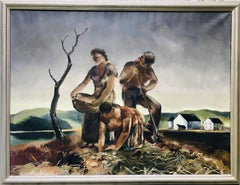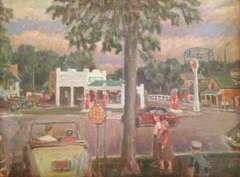Gerrit Van Sinclair Art
to
2
1
Overall Width
to
Overall Height
to
3
2
1
1
3
3
2
1
1
1
1
1
1
1
1
1
1
1
3
10,138
2,779
1,378
1,375
1
3
Artist: Gerrit Van Sinclair
"Parade" Social Realism Mid 20th Century Modern American Scene WPA Regionalism
By Gerrit Sinclair
Located in New York, NY
"Parade" Social Realism Mid 20th Century Modern American Scene WPA Regionalism
Gerrit Van Sinclair (1890 – 1955)
Parade
20 x 15 inches
Oil on board, c. 1940s
Signed lower right
Fram...
Category
1940s American Realist Gerrit Van Sinclair Art
Materials
Oil, Board
"Figure, " Nude Portrait Linoleum Cut by Gerrit Sinclair
By Gerrit Sinclair
Located in Milwaukee, WI
"Figure" is an original linoleum print by Gerrit Sinclair, signed in plate the lower left corner. It features a woman fixing her hair in front of a mirror, her nude body visible to the viewer from the back and front reflecting in the mirror.
Image: 6" x 5"
Framed: 13.37" x 12.43"
Gerrit Sinclair brought the charming style of American Regionalism painting...
Category
1930s American Realist Gerrit Van Sinclair Art
Materials
Linocut
'Jones Island' original woodcut engraving by Gerrit Sinclair
By Gerrit Sinclair
Located in Milwaukee, WI
The print 'Jones Island' is something of a self portrait. In the image, an artist stands before and easel, depicting the docks and buildings on the coast. The title indicates that this is Jones Island in Milwaukee, the peninsula along Lake Michigan that today is home to largely industrial buildings. The buildings and figures in the print suggest that this might be a view of the last of the Kashubian or German immigrant settlements on the peninsula before they were evicted in the 1940s to make way for the development of the harbor. The artist in the image thus acts as a documentarian of these peoples. The careful line-work of the woodblock engraving adds a sense of expressionism to the scene, leaving the figures and buildings looking distraught and dirty, though the image nonetheless falls into the Social Realist category that dominated American artists during the Great Depression.
This print was published in 1936 as part of the Wisconsin Artists' Calendar for the year 1937, which included 52 original, hand-made prints – one for each week of the year.
6 x 5 inches, image
10 x 7.13 inches, sheet
13.43 x 12.43 inches, frame
Signed "GS" in the print block,upper left
Entitled "Jones Island" lower left (covered by matting)
Inscribed "Wood Engraving" lower center (covered by matting)
Artist name "Gerrit V. Sinclair" lower right (covered by matting)
Framed to conservation standards using 100 percent rag matting and museum glass, all housed in a silver gilded moulding.
Gerrit Sinclair studied at the Art Institute of Chicago from 1910 - 1915, under Vanderpoel, Norton, and Walcott. In World War I, he served in the Army Ambulance Corps and later recorded his experiences in a series of oil paintings. He taught in Minneapolis before arriving in Milwaukee in 1920 to become a member of the original faculty of the Layton School of Art. He was also a member of the Wisconsin Painters & Sculptors.
Sinclair's paintings and drawings were executed in a lyrical, representational style, usually expressing a mood rather than a narrative. His paintings reveal a great sensitivity for color and atmosphere. His subject matter focused on cityscapes, industrial valleys, and working-class neighborhoods, captured from eye-level. A decade before the popularity of Regionalism, Sinclair's strong interest in the community was reflected not only in his paintings, but also in his encouragement to students to return to their communities as artists and teachers. Joseph Friebert...
Category
1930s American Modern Gerrit Van Sinclair Art
Materials
Engraving, Woodcut
Related Items
“New Americans" 1941 WPA Exhibited Carnegie Percy Albee
Located in Exton, PA
Monumental, important WPA painting signed by Percy Albee. The painting is oil canvas measuring 36" x 48". Titled verso "New Americans", this WPA painting was exhibited at the Carnegi...
Category
1940s American Realist Gerrit Van Sinclair Art
Materials
Oil
$6,000
H 40 in W 52 in D 2 in
Put Fighting Blood in Your Business
Located in Spokane, WA
Original WW1 poster. Put Fighting Blood in Your Business. Here’s his record! Does he get a Job? Arthur Woods, Assistant to the Secretary of...
Category
1910s American Realist Gerrit Van Sinclair Art
Materials
Lithograph
Elwood W. Bartlett, Wisconsin Farm, about 1945, mid-century wood engraving
Located in New York, NY
Elwood Warren Bartlett is a Wisconsin native who also worked in Indiana.
Largely self taught as a printmaker, Bartlett worked in a style that once identified as his, immediately t...
Category
1940s American Modern Gerrit Van Sinclair Art
Materials
Woodcut
Steps to the Grand Canal, St. Mark's in the distance, Venice.
By Donald Shaw MacLaughlan
Located in Middletown, NY
A lovely view of Venice from the water.
Etching with drypoint on antique cream laid paper with a large figural watermark, signed in pencil, lower right. 14 1/4 x 11 inches (362 x 280...
Category
Early 20th Century American Modern Gerrit Van Sinclair Art
Materials
Laid Paper, Drypoint, Etching
Cortland Street
Located in Middletown, NY
Etching with drypoint on antique handmade laid Japon paper, 12 7/8 x 7 1/2 (327 x 191 mm); sheet 15 5/16 x 10 7/16 (389 x 265 mm), full margins. Signed in pencil in the lower margin....
Category
Early 20th Century American Modern Gerrit Van Sinclair Art
Materials
Drypoint, Etching
Wuxtry! [Extra!]
By Albert Abramovitz
Located in New York, NY
Albert Abramovitz (1879-1963), Wuxtry! [Extra?!], linocut in colors, c. 1936, signed in pencil lower right and titled lower center [also initialed in the plate]. In very good conditi...
Category
1930s American Realist Gerrit Van Sinclair Art
Materials
Linocut
New York Skyline
By Louis H. Ruyl
Located in Middletown, NY
Etching with drypoint on cream wove paper with deckle edges, 4 3/8 x 12 3/4 inches (233 x 323 mm); sheet 9 1/2 x 15 3/4 inches (240 x 338 mm), full margins. Signed and numbered 4/75 ...
Category
Early 20th Century American Modern Gerrit Van Sinclair Art
Materials
Handmade Paper, Etching, Drypoint
Chicago Skyline
By Paul Schumann
Located in Middletown, NY
A beautiful turn-of-the-century lake view of Chicago by an American artist known for his Texas landscapes.
Etching with drypoint on watermarked Umbria laid paper with deckle edges, 7 1/4 x 10 7/8 inches (182 x 275 mm), full margins. Signed and numbered 4/25 in pencil, lower margin. In good condition with adhesive residue at the sheet edges on the verso, does not show through to the recto. A lovely Lake Michigan landscape...
Category
Early 20th Century American Modern Gerrit Van Sinclair Art
Materials
Handmade Paper, Etching, Drypoint
Blackfeet Indians, Great Northern Railway 14 prints
By Winold Reiss
Located in Spokane, WA
A group of 14 Blackfeet Indians prints created by the artist Winold Reiss. The Great Northern Railway printed and released these prints in c. 1940. This is for the entire group...
Category
1940s American Realist Gerrit Van Sinclair Art
Materials
Lithograph
$576 Sale Price
20% Off
H 12 in W 9 in D 0.05 in
Low Country (South Carolina)
By Elizabeth Verner
Located in Middletown, NY
An enchanting Southern landscape by the mother of the Charleston Renaissance.
A native of Charleston, South Carolina, and educated under the tutelage of Thomas Anshutz at The Pennsylvania Academy of Fine Arts, O'Neill Verner was a teacher, a mother, an artist, an ardent preservationist, and a skilled autodidact. Having previously focused on painting, in the early 1920s she found herself deeply moved by printmaking as a media, and especially so by the simple, peaceful themes and tableaus she discovered in Japanese art. She embarked on a effort to teach herself Japanese printmaking techniques, and in the process, produced the charming images of every day life in Charleston and its environs that earned her recognition as a cultural icon in her day, and in more modern times, as the mother of the Charleston Renaissance, which flourished well into the 1930s. In 1923 she opened a studio in Charleston where she focused on documenting the local color and the architecture and landscape that distinguishes Charleston as one of the South's most beautiful cities, all the while applying the gentle and poetic thematic sensibilities of Japanese printmaking. O'Neill Verner soon found herself in high demand when municipalities and institutions throughout the country sought commissions from her to document the beauty of their grounds and historic buildings. She worked as far north as the campuses of Harvard and Princeton, and extensively across the South, including in Savannah, Georgia, where through sweeping commissions she was able to marry her love of southern preservation and art. O'Neill Verner was a lifelong learner, and continued a path of edification that led her to study etching at the Central School of Art in London, to travel extensively through Europe, and to visit Japan in 1937, where she studied sumi (brush and ink) painting. She was a founding member of the Charleston Etchers Club, and the Southern States Art League. Her works are represented in the permanent collections of leading museums across the American south, and in major national institutions including the Metropolitan Museum of Art, Boston's Museum of Fine Art, and the Smithsonian American Art Museum. O'Neil Verner...
Category
Early 20th Century American Modern Gerrit Van Sinclair Art
Materials
Archival Paper, Drypoint, Etching
Hommage a Christian Dior original French vintage fashion poster
By René Gruau
Located in Spokane, WA
Original vintage French poster: Christian Dior Homage. (Homage à Christian Dior)
Artist: Rene Gruau. Mint condition Original.
Size: 15.75" x 24" Very fine condition; read...
Category
1980s American Realist Gerrit Van Sinclair Art
Materials
Offset
$236 Sale Price
20% Off
H 24 in W 15.75 in D 0.05 in
Original "Me Travel? not this summer Vacation At Home vintage poster 1945
Located in Spokane, WA
Original World War Two, U. S. Military poster: ME TRAVEL? … NOT THIS SUMMER, VACATION AT HOME. Artist Albert Dorne. This is the large format printing (26" x 37") of this poster...
Category
1940s American Realist Gerrit Van Sinclair Art
Materials
Offset
$719 Sale Price
20% Off
H 37 in W 26 in D 0.05 in
Previously Available Items
Neighborhood Texaco Station
By Gerrit Sinclair
Located in Los Angeles, CA
Oil on Canvas, unsigned, but letter of authenticity by Michael Hall expert.
12 x 16 Inches.
Gerrit Van Sinclair was born in Grand Haven, Michigan in 1...
Category
1930s American Realist Gerrit Van Sinclair Art
Materials
Canvas, Oil
Gerrit Van Sinclair art for sale on 1stDibs.
Find a wide variety of authentic Gerrit Van Sinclair art available for sale on 1stDibs. You can also browse by medium to find art by Gerrit Van Sinclair in engraving, linocut, woodcut print and more. Much of the original work by this artist or collective was created during the 1930s and is mostly associated with the modern style. Not every interior allows for large Gerrit Van Sinclair art, so small editions measuring 13 inches across are available. Customers who are interested in this artist might also find the work of Armin Landeck, Felix de Weldon , and Warrington Colescott. Gerrit Van Sinclair art prices can differ depending upon medium, time period and other attributes. On 1stDibs, the price for these items starts at $1,283 and tops out at $1,300, while the average work can sell for $1,292.
